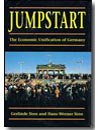The promised “blossoming landscapes” have not been achieved in the eastern part of Germany. The new federal states are still waiting for a self-sustaining economic upswing. Per capita economic output for the working-age population in the territory of the former German Democratic Republic has only reached two thirds of the economic performance in the west. The new federal states never really had a chance because the economic order of the Federal Republic of Germany with its wage and social-insurance regulations was simply imposed on the former GDR, contrary to the advice given by economists. Instead of an economic miracle a second mezzogiorno in Europe arose, a limbering economic region that has not managed to connect with the better developed regions of the country. The only force behind a convergence of the per capita economic output is migration.
TV Lectures
Can Germany Still be Saved? - Theses on the Future of the Republic. Information page
Refereed scientific monographs
Can Germany be Saved? The Malaise of the World’s First Welfare State, MIT Press: Cambridge, Mass., 2007, 356 pages. (Revised and updated translation of Ist Deutschland noch zu retten?); Chapter 5: “The Withering East”. To Amazon.
 Jumpstart. The Economic Unification of Germany, MIT Press: Cambridge, Mass., and London 1992, 238 pages, with Gerlinde Sinn. (Revised translation of Kaltstart). Second English edition: MIT Press, 1993. Korean, French and Russian editions 1994. Chinese edition 2012. To Amazon.
Jumpstart. The Economic Unification of Germany, MIT Press: Cambridge, Mass., and London 1992, 238 pages, with Gerlinde Sinn. (Revised translation of Kaltstart). Second English edition: MIT Press, 1993. Korean, French and Russian editions 1994. Chinese edition 2012. To Amazon.
Articles in refereed journals
"Germany's Economic Unification. An Assessment After Ten Years“, Review of International Economics 10, 2002, pp. 113-128; (Download, 108 KB); CESifo Working Paper No. 247, February 2000; NBER Working Paper No. 7586, March 2000.
"EU Enlargement, Migration, and Lessons from German Unification“, German Economic Review 1, 2000, pp. 299-314; (Download, 1.1 MB); CESifo Working Paper No. 182, 1999.
"Privatization in East Germany", in: P. Pestieau, Hrsg., Public Finance in a World of Transition (IIPF congress St. Petersburg 1991), Public Finance, Supplement to Vol. 47, 1992, pp. 152-171; (Download, 730 KB); CESifo Working Paper No. 8, 1991; NBER Working Paper No. 3998, February 1992.
Academic papers in conference volumes
"International Implications of German Unification“, in: A. Razin and E. Sadka, eds., The Economics of Globalization, Cambridge University Press: Cambridge 1999, pp. 33-58 (Download, 1.78 MB); CESifo Working Paper No. 117, 1996; NBER Working Paper No. 5839, November 1996.
"What Can Korea Learn from German Unification?" (together with Gerlinde Sinn), in: B. Hwang and Y. Yoon, eds., Middle Powers in the Age of Globalization. Implications for Korean Political Economy and Unification, The Korean Institute of International Studies: 1996, pp. 357-363 (Download, 242 KB).
"Macroeconomic Aspects of German Unification", in: P.J. Welfens, ed., Economic Aspects of German Unification, Springer: Berlin, Heidelberg, New York etc. 1992, pp. 79-133 (Download, 1.3 MB); NBER Working Paper No. 3596, January 1991.
Policy Contributions in Journals and Academic Volumes
"Do not perpetuate the Dutch Disease in Europe: Lessons from German reunification for a European Fiscal Union" (together with Gerlinde Sinn), VOX, voxeu.org, November 1st, 2015.
Short Policy Contributions and Newspaper Articles
"Muffled jumpstart", VOX, www.voxeu.org, November 9th, 2009.
Ifo Viewpoints
Ifo Viewpoint No. 170: Do Not Perpetuate the Dutch Disease in Europe: Lessons from German Reunification for a European Fiscal Union, Nov 9, 2015.
Ifo Viewpoint No. 55: Equivalent Standards of Living and Factor Price Equalization, Sep 15, 2004.
Ifo Viewpoint No. 32: Germany's Anaemic Growth, May 17, 2002.
Ifo Viewpoint No. 12: A Transfer Economy, Jun 30, 2000.
Ifo Viewpoint No. 3: Ten Years of Eastern German Recovery, Oct 26, 1999.